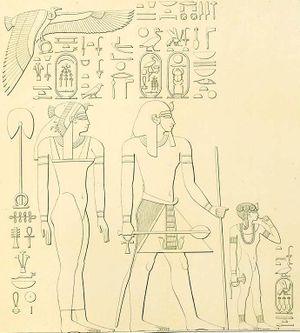أحمس (ملكة)
| أحمس | |||||
|---|---|---|---|---|---|
| عقيلة ملك مصر الزوجة الملكية العظيمة | |||||
 تحتمس الأول وزوجته أحمس برفقة ابنتهما الكبرى. | |||||
| وُلِد | طيبة؟ | ||||
| توفي | طيبة | ||||
| المدفن | |||||
| الزوج | تحتمس الأول | ||||
| الأنجال | حتشپسوت نفروبيتي | ||||
| الاسم المصري |
| ||||
| الأسرة المالكة | الأسرة 18 | ||||
| الديانة | الديانة المصرية القديمة | ||||
أحمس، هي ملكة مصرية قديمة في الأسرة الثامنة عشر. كانت الزوجة الملكية العظيمة لثالث فراعنة الأسرة، تحتمس الأول، ووالدة الملكة والفرعونة حتشپسوت. اسمها يعني "وُلدت من القمر".
العائلة
ولا يُعرف من هو والد أحمس ووالدتها.[1] وقد اقترح أن أحمس كانت إما ابنة الفرعون أمنحوتپ الأول أو ابنة الفرعون أحمس الأول وربما زوجة أخت أحمس الأول أحمس-نفرتاري. لم تُلقب أحمس قط بابنة الملك. هذه الحقيقة تثير بعض الشك حول هذه النظريات حول علاقات أحمس بالعائلة المالكة. ومع ذلك، حملت أحمس لقب أخت الملك. وقد يشير هذا إلى أنها كانت أخت الفرعون تحتمس الأول.[2]
تم التعرف على أحمس بمجموعة رائعة من الألقاب: الأميرة الوراثية (iryt-p`t)، عظيمة الثناء (wrt-hzwt)، سيدة الجمال المحبوبة العظيمة (nebt-bnrt-'3(t)-mrwt)، زوجة الملك العظيم، ومحبوبته (hmt-niswt-wrt meryt.f)، سيدة السعادة (hnwt-ndjm-ib)، سيدة جميع النساء (hnwt-hmwt-nbwt) )، سيدة الأرضين (hnwt-t3wy)، رفيقة حورس (zm3yt-hrw)، رفيقة حورس المحبوب (zm3yt-hrw-mryt.f)، وأخت الملك (snt-niswt)[3]
أحمس هي الزوجة الملكية العظيمة لتحتمس الأول. وقد تم تصويرها في الدير البحري وتظهر هناك مع ابنة تدعى نفروبيتي. وكانت أحمس أيضًا والدة الملكة-الفرعون حتشپسوت. ومن غير المعروف على وجه اليقين ما إذا كان الأمراء آمنمسى ووادجموسى من أبنائها. ويُعتقد عمومًا أنهم أبناء زوجة أحمس الأخرى الملكة موت نفرت.
الآثار والنقوش
An official named Yuf served as the second prophet of the dues (S'w) of the altar, the doorkeeper of the temple, and as a priest. He also served several royal women. He first served queen Ahhotep, the mother of pharaoh Ahmose I, he was responsible for repairing the disturbed tomb of Queen Sobekemsaf, and eventually served Queen Ahmose. Yuf recorded that Queen Ahmose appointed him as assistant treasurer and entrusted him with the service to a statue of her majesty[4]
Ahmose features prominently in the divine conception scenes. Hatshepsut had scenes created showing how the god Amun approached her mother, Ahmose, and how she (Hatshepsut) was of divine birth. The inscriptions show how the god Thoth first mentions Queen Ahmose to Amun. "Ahmose is her name, the beneficent, mistress of [--], She is the wife of the king Aakheperkare (Thutmose I), given life forever" (from Breasted's Ancient Records).[5] The god Amun then proceeds to the palace and makes himself known to the Queen. They proceed to conceive a child and Amun declares that she should be named Khnemet-Amun-Hatshepsut. Amun proceeds to the god Khnum and instructs him to create Hatshepsut. The scenes continue to show the confinement of the queen and the birth of her divine daughter.
Many years later Pharaoh Amenhotep III copied these scenes almost exactly to show how Amun visited his mother, Queen Mutemwiya, and conceived the royal prince.
المصادر
- ^ Dodson, Hilton, The Complete Royal Families of Ancient Egypt, 2004
- ^ Tyldesley, J, Chronicles of the Queens of Egypt, 2006
- ^ W. Grajetzki: Ancient Egyptian Queens: a hieroglyphic dictionary.
- ^ James Henry Breasted: Ancient Records of Egypt. Vol II, Chicago 1906, S. 44–46 [1]
- ^ J. H. Breasted, Ancient Records: The Eighteenth Dynasty
